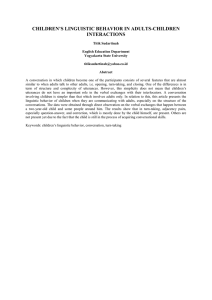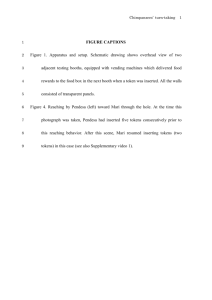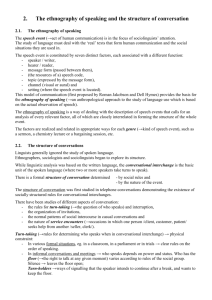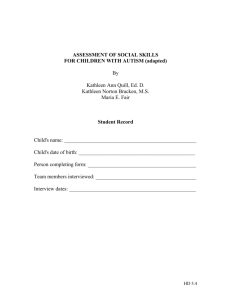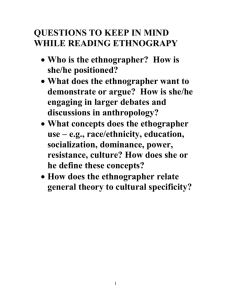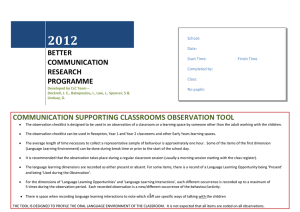A Constraint Satisfaction Framework for Managing Mixed-Initiative Discourse
advertisement
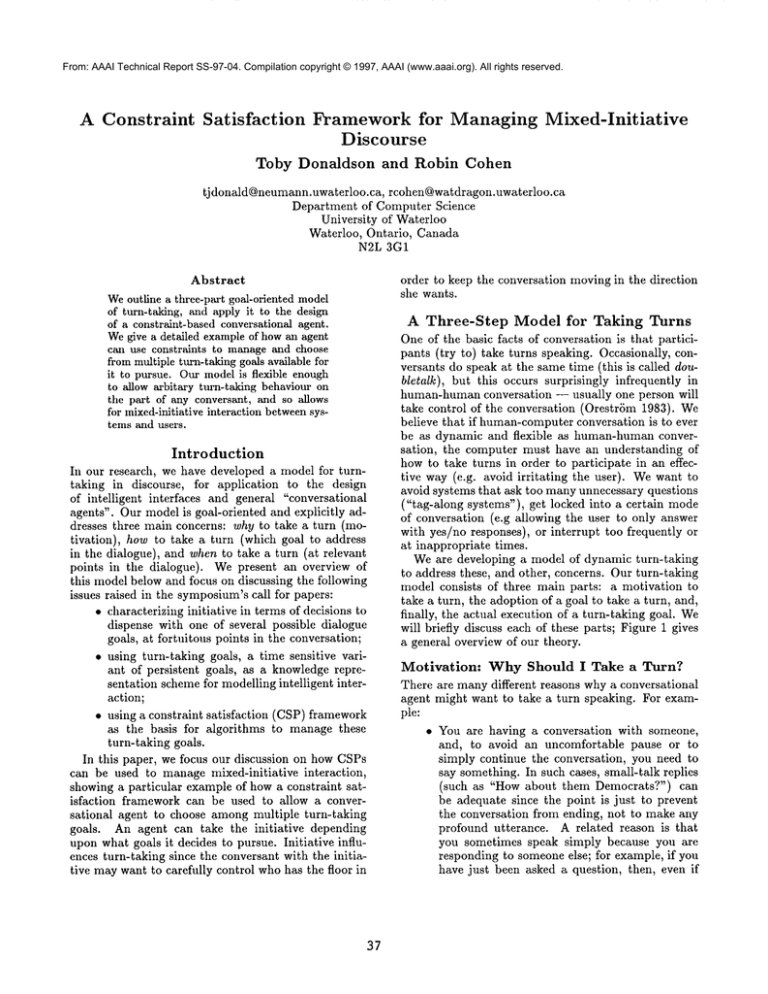
From: AAAI Technical Report SS-97-04. Compilation copyright © 1997, AAAI (www.aaai.org). All rights reserved.
A Constraint
Satisfaction
Toby
Framework for Managing Mixed-Initiative
Discourse
Donaldson
and
Robin
Cohen
tjdonald@neumann.uwaterloo.ca, rcohenQwatdragon.uwaterloo.ca
Department of Computer Science
University of Waterloo
Waterloo, Ontario, Canada
N2L 3G1
Abstract
Weoutline a three-paa-t goal-oriented model
of turn-taking, and apply it to the design
of a constraint-based conversational agent.
Wegive a detailed exampleof howan agent
can use constraints to manageand choose
from multiple turn-taking goals available for
it to pursue. Our modelis flexible enough
to allow arbitary turn-taking behaviour on
the part of any conversant, and so allows
for mixed-initiative interaction betweensystems and users.
order to keep the conversation movingin the direction
she wants.
Introduction
In our research, we have developed a model for turntaking in discourse, for application to the design
of intelligent interfaces and general "conversational
agents". Our model is goal-oriented and explicitly addresses three main concerns: why to take a turn (motivation), how to take a turn (which goal to address
in the dialogue), and whento take a turn (at relevant
points in the dialogue). Wepresent an overview of
this model below and focus on discussing the following
issues raised in the symposium’scall for papers:
¯ characterizing initiative in terms of decisions to
dispense with one of several possible dialogue
goals, at fortuitous points in the conversation;
¯ using turn-taking goals, a time sensitive variant of persistent goals, as a knowledge representation schemefor modelling intelligent interaction;
¯ using a constraint satisfaction (CSP) framework
as the basis for algorithms to manage these
turn-taking goals.
In this paper, we focus our discussion on how CSPs
can be used to manage mixed-initiative interaction,
showing a particular example of how a constraint satisfaction framework can be used to allow a conversational agent to choose among multiple turn-taking
goals. An agent can take the initiative
depending
upon what goals it decides to pursue. Initiative influences turn-taking since the conversant with the initiative maywant to carefully control whohas the floor in
37
A Three-Step
Model for Taking
Turns
One of the basic facts of conversation is that participants (try to) take turns speaking. Occasionally, conversants do speak at the same time (this is called doubletalk), but this occurs surprisingly infrequently in
human-humanconversation -- usually one person will
take control of the conversation (OrestrSm 1983).
believe that if human-computerconversation is to ever
be as dynamic and flexible as human-humanconversation, the computer must have an understanding of
howto take turns in order to participate in an effective way (e.g. avoid irritating the user). Wewant
avoid systems that ask too many unnecessary questions
("tag-along systems"), get locked into a certain mode
of conversation (e.g allowing the user to only answer
with yes/no responses), or interrupt too frequently or
at inappropriate times.
Weare developing a model of dynamic turn-taking
to address these, and other, concerns. Our turn-taking
model consists of three main parts: a motivation to
take a turn, the adoption of a goal to take a turn, and,
finally, the actual execution of a turn-taking goal. We
will briefly discuss each of these parts; Figure 1 gives
a general overview of our theory.
Motivation:
Why Should I Take a Turn?
There are manydifferent reasons why a conversational
agent might want to take a turn speaking. For example:
¯ You are having a conversation with someone,
and, to avoid an uncomfortable pause or to
simply continue the conversation, you need to
say something. In such cases, small-talk replies
(such as "How about them Democrats?") can
be adequate since the point is just to prevent
the conversation from ending, not to make any
profound utterance. A related reason is that
you sometimes speak simply because you are
responding to someoneelse; for example, if you
have just been asked a question, then, even if
Raw perceptions
transformed into
goals
[l
i_!
Perceptions
.............
Dynamic CSP used
to select and order
goals
Time-bounded
persistent goals
!
-[
! .....
Goals
’~
Goals
signals
/
Goals are
executed
ordered
~_! !_ !_ D!?_o??~r?~nts_
Step 1:
Motivation
Watch for turn-yielding
j
I
Step 2:
Goal adoption
..................
Step 3:
Turn execution
Figure 1: The 3-step model for taking a turn.
you are not sure of the answer, you ought to
respond to the question, by default;
other conversant to see whenshe is willing to give up
the floor.
¯ Something the other conversant has said is
somehow"physically" hard to understand: you
might not have heard an important part of what
they said (and so ask them to speak again);
¯ Youare reacting to a typical conversational setting, such as buying a ticket for a concert where
the conversants follow a standard turn-taking
pattern.
There are also turn-taking motivations which arise
when a conversational agent has the overall task of
informing or advising the user, such as:
¯ Another conversant’s utterance might cause you
to believe that a contradiction has arisen -- either you believe someinconsistency, or you believe they believe some inconsistency. One way
to resolve an inconsistency is to take a turn and
ask the other conversant about it;
¯ You lack some important piece of information,
and so ask the other person (this is the idea behind the missing axiom theory of conversation
in (Smith, Hipp, & Biermann 1995));
¯ You have some important piece of information
that you want to communicate,e.g. a fire in the
building, that someonehas just won the lottery,
that their mother just called, etc.;
A number of these motivations follow from the simple
idea that asking someoneelse is often the best way to
get things done.
Motivations are not sufficient for modelling turntaking because simply wanting to say something does
not mean you should say something. An agent will
typically have more than one thing to potentially say
at any one time, so it must be able to decide which one
thing it will actually speak about. Furthermore, there
is necessarily more than one agent in a conversation,
and good turn-taking involves listening carefully to the
38
Goal Adoption:
What Should
Want to Take a Turn?
I do When I
In order to handle multiple turns, and to allow turntaking goals to be put off until the right moment,we
require that the raw motivations be transformed into
turn-taking goals. Wemodel turn-taking goals as a
kind of time-bounded persistent goal (Donaldson & Cohen 1996). Time-bounded persistent goals, which are
an extension of persistent achievement goals as defined
by Cohen and Levesque (Cohen & Levesque 1990), take
the following general form:
Bounded-persistent-goal(¢,T)
While:
simple-goal (¢)
Adopt-when:B( holds( B-,¢,some-head-of (T)
Drop-when:B( holds( B¢,some-tail-of ( T)
B( holds( B~¢,some-taiI-of (T)
B(after(T,now))
This means that the agent has persistent goal to make
¢ true for some interval of time that ends T. Bp means
that the agent believes proposition p to be true, and
the notation some-head-of(T) and some-tail-of(T) is
shorthand for unspecified intervals of a general time
interval T that touch one end of T. A goal is adopted
whenall of the conditions on the While list and Adoptwhenlist hold, and none of the conditions on the Dropwhen list hold. Time-bounded persistent goals are
goals that an agent persists in trying to achieve for
some finite interval of time; the agent may or maynot
be certain of the exact end-points of the interval, but it
is always aware of its finiteness. Time-boundedpersistent goals provide a convenient way to represent "intervals of relevance" in a conversation, and, through the
use of explicit adopt/drop conditions, they are very
similar to STRIPS planning operators, allowing new
1kinds of goals to be conveniently defined.
One of our major concerns is how to deal with multiple turn-taking goals. For example, if someonesays
to you "Are you hungry? Want to go for lunch?", a
number of possible responses might occur to you, depending on the situation: you might need to decide
between giving a straight yes/no answer, or expressing
your surprise that it is already time for lunch. At any
given time, a conversational agent can have more than
one turn-taking goal to choose from, and thus must
settle upon which goal to actually try to achieve. We
have chosen a dynamic constraint satisfaction (DCSP)
framework in which to manage multiple goals, which
we discuss in the section on goal management.
Execution:
When Should
I Take a Turn?
Finally, once a conversational agent has decided which
turn-taking goal to try to execute, it still must take
into account one extremely important factor: the other
conversant! Since avoiding doubletalk is important, an
agent with a goal to take a turn must be careful to take
its turn at the right time in the conversation. To do
this in human-humanconversation, a person must be a
good listener: she must look for the appropriate turnyielding signals from the current speaker, signals such
as pauses, changes in inflection, grammatical boundaries, gestures (Orestr6m 1983; Goldman-Eisler 1968).
For example, a pause is often a good indicator of a
speaker’s willingness to give up the floor, but not always. Sometimes a pause simply indicates that the
speaker is thinking, and so perhaps does not want to
be interrupted. Whena number of turn-yielding signals occur at the same time, that likely indicates a good
time for a person to take a turn. For human-computer
conversation, we wouldultimately like to develop a system that could take advantage of these same signals in
order to engage in smooth conversational turn-taking.
Tension exists between the desire for an agent to
execute its turn-taking goals, and the desire not to
haphazardly interrupt the other speaker. Sometimes,
the agent may guess wrong (i.e. not interrupt when
it should have interrupted),
and, due to the timebounded nature of turn-taking goals, be forced to drop
a goal because the time of relevance has passed. The
opposite problem is jumping in at the wrong time,
which causes the conversation to flow less smoothly.
Summary
This section has outlined in full our proposed modelfor
turn-taking in discourse. These three steps are meant
1 Onepotentially interesting consequenceof this kind of
flexibility is that it should be possible to changethe level
of persistence for these goals, and so provide someempirical support for Cohenand Levesque’stheory of persistence.
For example, we could makeagents less persistent by requiring less strict drop conditions, and showthat this results in less appropriatetin’n-taking behaviottr.
39
to be occurring continuously and in parallel throughout the conversation. Motivations can be occurring all
the time, a conversational agent can almost always be
thinking, and an agent should be ready to speak at
almost any time, according to the actions of the other
conversant. In the remainder of the paper, we focus on
howa conversational agent can use a constraint satisfaction framework to manage the various turn-taking
goals that can arise in a conversation. Wealso use the
sample application of advice-giving, where the conversational agent is an advising system, making decisions
in order to interact with a user.
Managing
Goals
via Dynamic
Constraint
Satisfaction
Constraint satisfaction problems (CSPs) are a popular
formalism for representing problems wherein the goal
is to find a consistent assignmentof values to variables
(Tsang 1993). Various constraints hold between variables, and the problem is to find an assignment that
breaks as few constraints as possible (a CSP can be
over-constrained, meaning that every possible assignment of values to variables breaks at least one constraint). Wepropose to manage the turn-taking goals
that arise in multi-utterance discourse by using a CSP
to manage the selection of turn-taking goals. In our
model, every utterance a speaker makes will cause the
listener to adopt a number of potential turn-taking
goals; the listener must then order these goals, and
choose the most appropriate one to actually pursue.
Turn-taking
CSPs
A CSP consists of variables, possible domain values
for each variable, and constraints between variables.
In our domain, variables act as place-holders for goals
(they can be thought of as, roughly, being the working memoryof a conversational agent); we refer to the
resulting CSPas a turn-taking CSP. A conversational
agent’s turn-taking CSPwill have k variables 111,... Vk,
each capable of holding one turn-taking goal. If an
agent is required to act immediately, then it will first
try to achieve the goal stored in V1, then V2, and so on.
The goals that fill the variables, G1,..., Gn, are triggered by utterances from the user, and stored in one
large pool of goals. The CSPmust decide which goals
should go into the ~’s, and in what order. It does
this by examining the constraints that hold between
the variables, and trying to assign goals that break as
few constraints as possible.
Given that an agent could be required to speak at
any time (i.e. the choice of when to speak in a conversation often depends on when the current speaker
is willing to give up her turn), and given that there is
no guarantee that the relevant constraints will be not
be so constraining as to make a perfect solution impossible, we propose to solve turn-taking CSPs using
heuristic repair methods, algorithms similar in style
to the rain-conflicts heuristic (Minton et al. 1990)
and GSATalgorithms (Sehnan, Kautz, & Cohen 1994).
Such algorithms start from a completely instantiated
CSP, choose a variable according to some heuristic,
and then choose a value for that variable by another
heuristic (these heuristics often use some kind of randomness). This is a kind of hill-climbing search that
has been shown to be highly effective in certain domains. This method is appropriate for solving turntaking CSPs since it provides an anytime algorithm, it
handles over-constrained and under-constrained problems in the same manner, it allows for the re-use of
previous solutions, it is memoryefficient, and it can
2sometimesbe very time-efi:icient.
It is our claim that the kind of CSPdeveloped here,
which is appropriate for handling single utterances, can
be extended to handle multiple utterance discourse in a
straightforward way. Note that a single turn can easily
consist of multiple utterances, thus our model allows
for the possibility of intra-turn interruptions. Below
we give an example of how a single utterance triggers
various goals in the system, and how the listener orders these goals via constraint satisfaction. Whennew
utterances appear, this cycle repeats; the turn-taking
CSP changes since, at least, old goals disappear and
new goals arrive. Consideration of multiple utterances
will require attention to other linguistic concepts, such
as focus, and the use of cue phrases. Thus, multiutterance discourse is a problem that must be modelled as a dynamic CSP(e.g. (Dechter ~ Dechter 1988;
Mittal & Falkenhainer 1990)). Wecommentbriefly
how to approach the problem of dynamic CSPs in the
concluding section of the paper.
Kinds of Goals
A turn-taking CSPorders turn-taking goals. Weuse a
very simple notion of goal to model turn-taking goals:
¯ Each turn-taking goal is associated with exactly
one action;
¯ Turn-taking goals are assumed to be persistent,
in the sense that an agent will not adopt/drop
them in a highly erratic manner;
¯ Each turn-taking goal will be of a certain type
(given below);
¯ Turn-taking goals are associated with a temporal interval of relevance, which is meant to
help model important ideas such as focus, which
will become important when multiple utterances and turns come into play.
The particular types of turn-taking goals that are
relevant depend upon the type of discourse in which
2 The performanceof local search is apparentlyquite sensitive to the domain,heuristic, and representation used. So
far, experimentationis the best wayto determine if a local search algorithm will provide better performancethan
a standard CSPback-tracklng style algorithm. Weare currently investigating the use of local search algorithms in a
numberof CSPdomains, including tunl-taking CSPs.
4O
one is engaging. For advice-giving settings, we have
identified the following turn-taking goal-types:
¯ repair goals:
- information repair goals (i.e. fixing of faulty
information that a conversant is believed to
possess);
-contradiction repair (i.e. reconciliation of
contradictory utterances/beliefs);
¯ clarification goals:
- domain plan clarification
(i.e. determining
the higher-level goals behind the utterance);
-meaning clarification
(e.g. requesting the
meaning of an unfamiliar word used by the
speaker);
- linguistic clarification (i.e. cases where some
sort of noise, such as a spelling mistake in
written discourse, has prevented the listener
from clearly interpreting the utterance);
¯ information-seeking goals;
¯ question-answering goals.
This list is not intended to be exhaustive; determining
which types of goals are most useful for which domains
is a topic for future investigation.
Another factor which we believe will influence the
kinds of goals available are the actions that can be
associated with the goals. If a system has a domain
plan clarification goal, then whenit comes time to try
to achieve that goal, the system can hand over control
of the conversation to a module that handles only that
type of subdialogue. Whenthe module has finished
executing, it can then return control back to the 3CSP.
CSP Constraints
The turn-taking CSPorders turn-taking goals by selecting goals that best satisfy the constraints on the
CSPvariables. In this section, we discuss what kinds
of constraints we intend to put on a turn-taking CSP:
General Constraints These are constraints that refer to general properties of turn-taking goals:
¯ No two variables should hold the very same
goal;
¯ If Ga is a sub-goal of Gb, then Ga should come
before Gb;
¯ If the endpoint of Ga’s interval of relevance
is before, or coincident with, the beginning
point of Gb’s interval of relevance, then Ga
should come before Gb.
3Aparticular subdialoguemoduleitself need not explicitly deal with goals in the same way as the turn-taking
CSPdoes (although, of course, it would need to communicate what it has achieved), nor does it need to offer the
sameflexibility.
Goal-type Constraints These constraints refer to
the type of a goal, and we refer here only to
the goal types listed previously. Again, these
constraints are the initial ones we wouldlike to
consider, and we expect they may well change
and be made more precise through experience:
* related clarification and repair goals comebefore related information-seeking goals (rationale: information obtained while a potential
problem is pending may be bad information
that causes problems later);
. related linguistic clarification goals comebefore related meaningclarification goals (rationale: before you can understand the meaning of the linguistic utterance, you should
make sure that you have heard the utterance
clearly);
. related meaning clarification goals come before related domainplan recognition clarification goals (rationale: you should makesure
you understand an utterance before you start
using it to infer a higher-level plan);
¯ related clarification goals should be done before related answering goals (rationale: giving an answer while an ambiguity exists could
lead to giving an unhelpful or even incorrect
answer).
Example: Ordering
Goals in Response to a
Single Utterance
As a simple example of howa conversational agent can
use a turn-taking CSPto go from hearing an utterance
to deciding which turn-taking goal to pursue, we use a
simple example from the course-advising domain. We
assume a student is conversing with a system acting as
a course advisor; the student can ask questions about
courses, their pre-requisites, programoptions, etc., and
the system possesses the necessary knowledge to provide accurate and helpful responses.
Suppose the student asks Can I take CS1507. We
take this to be a simple question, which triggers a number of turn-taking goals:
GI: question-answering (the user has asked a question,
so answer it!);
G2: meaning clarification (find out what semester the
student is referring to);
G3: domain plan clarification
(find out what domain
4plan the user is pursuing);
G4: information-seeking goal (find out if the student
has taken the necessary pre-requisites).
4 Wemeanby this that the systemshould try to find out
what higher-level goal the student is trying to achieve by
taking the course, since a cooperative response to the user
maybe different dependinguponthe possible faults in the
student’s overall plan. See (Cohen, Schmidt, & van Beek
1994)for moredetails.
41
For simplicity, we make a number of assumptions. We
assume that these are the only goals that the system needs to consider, and use four CSP variables,
V1,..., V4. Weassume that G1 is a super-goal of the
other three goals, all the goals are related, and that
no time-interval constraints come into play (i.e. we
are only worried about what to say for the very next
turn).
Wealso need to specify a scoring system for sets
of constraints.
For this example we define a simple scoring function f that adds a penalty amount
for every constraint violation an instantiation incurs.
For every domain constraint that is broken, f adds
a penalty of 5, and for every goal-type constraint
that is broken, f adds a penalty of 1. For example, if A1 = {V1 : G1,V2 : G2, V3 : G3, V4 : G4}
and A2 = {V1 : G4, V2 : G3, V3 : G2, V4 : G1}, then
f(A1) = 15 and f(A2) = 5 The pr oblem is to fin d
an assignment of goals to variables that minimizes f.
As discussed previously, we propose to solve this
CSPusing heuristic repair methods. Wewill not trace
through a detailed example, but the operation of, for
instance, the min-conflicts heuristic is straightforward.
First, an initial solution is chosen, either randomlyor
by some other means. Next, the following procedure is
repeated indefinitely:
¯ select a variable that is participating in a conflict;
¯ assign to this variable the value that decreases
the score the most;
In both steps, ties are broken randomly. This process
is repeated indefinitely, until either a perfect solution
is found, or somere-start mechanismis called (i.e. to
escape from local minima). At any time during this
process, the best solution found so far can be returned.
Suppose the system hears the utterance, triggers all
the goals, and then decides that it has spent enough
time thinking, and must speak. 6 By thinking is meant
that it has run some heuristic repair algorithm on its
turn-taking CSP. Suppose that the best solution it
found was A2, and that it does no more thinking (a
simplifying assumption, since new utterances will trigger new goals that should be considered). It would:
1. (G4) Try to seek information about whether
not the student has achieved the necessary prerequisites;
2. (G3) Try to figure out what the student’s domain plan is;
5Thenotation ~ : Gomeansthat variable V,. is assigned
value Ga.
6Deciding when to speak is step 3 of our turn-taking
model, and we will not address this problem here. Note
that (Carletta 1992) has shown that a speaker may need
to take a turn, prematurely whenthe other conversant has
unexpectedly given up the floor.
3. (G2) Try to determine which semester the
CS150course the student is referring to occurs
in;
4. (G1) Try to answer the student’s original question.
This is not an optimal ordering, but it is a reasonable
set of actions to pursue; given more time to think, the
system may have found an ordering with fewer penalty
points (e.g. f({V1 G2, V2 : G3, V3: G4, V4 :G1})
1). Thus, when the system is required to speak, it
would perform the action associated with G4. After
that action is completed, and if no more processing
has been done by the system, then it would perform
the action associated with G3, and so on.
Discussion
In this paper, we have studied howan intelligent system interacting with a user or with other intelligent
agents can manage a dialogue in which direction and
control shift amongparticipants. Our focus has been
on specifying how a system can decide when to take a
turn and what to say, at any given point in the dialogue.
Someprevious work has dealt more or less explicitly with turn-taking and initiative. Traum & Hinkelman (1992) present a model of conversation acts for
task-oriented dialogue that includes both a very general description of turn-taking actions, and the idea of
initiative. They define the conversant with the local
initiative as the one with "the most recent discourse
obligation", and the initiator as the conversant who
performs the initiate act to begin a new discourse unit.
Walker & Whittaker (1990) use the idea of control,
which is similar to initiative, and discuss, for example, whenit is appropriate for a listener to interrupt in
terms of a tracking of the discourse to date. Smith et al
(1995) describe a dialog system that uses the missing
axiom theory as its dialogue control mechanism, which
causes an agent to take turn when it lacks an "axiom"
to prove the theorems it is concerned with.
Work has also been done on a number of related
issues. For example, previous work in advising dialogs
(Chu-Carroll & Carberry 1995; Cohen, Schmidt, & van
Beek 1994) has dealt with the issue of knowing when
and how to initiate a particular kind of subdialogue,
such as information-seeking, meaning-negotiation, and
clarification
subdialogues. The work presented here
goes further in terms of offering a general framework
in which such kinds of dialogues can by dynamically
initiated and controlled.
Our work addresses more specifically the topic of
mixed-initiative interaction in the following way. Our
design is primarily one where a system represents its
own dialogue goals and then determines when it is best
to take a turn during interaction with a user. But
our model also allows for the user to take a turn to
do something non-standard in its interaction with the
42
system. For instance, a user may elect to answer a
question with a question, rather than an answer. A
system which takes its turns according to a collection
of dialogue goals can simply add to its list the goal of
answering the current question of the user; then the
importance of this goal can be judged with respect to
the previous goal of advising or clarifying (the reason
why the system generated the question to the user in
the first place). In this respect, the model which we
propose, employing time-bounded persistent goals, allowing any goal which currently persists to be a candidate for the system’s next move, and then specifically
addressing which goal to select and which point in the
interaction to take a turn, is a modelwhich provides for
great flexibility in the structure of interaction between
system and user.
For future work, we are considering ways to augment
local search for solving CSPs. One intriguing combination is the use of a simple case-based retrieval system for initiating and augmenting the heuristic repair
search. Everyday experience suggests that many conversational utterances are quick "canned" responses,
in answer to commonquestions (such as what the time
is, or where someone’soffice is, etc.). Instead of solving these turn-taking problems by searching for an appropriate ordering of turn-taking goals, it seems more
plausible that people are simply retrieving a case that
they have encountered before, and using that to guide
their current actions (i.e. either by executing that particular case, or quickly adapting it for the current sitnation). Thus, we can augment the heuristic repair
method by saving old cases (i.e. the circumstances
of a previous conversation, and the goal-ordering that
was used in that situation), and then, before beginning
the repair, searching the case-base to find the bestmatching previous case to initialize
the turn-taking
CSP. Sometimes, the retrieved case may be a good
enough match for the current situation and so can be
used without resorting to any search at all (e.g. this
could happen with small-talk, as when someone says
"Howare you today?" and you typically respond with
"Not bad. And yourself?"). Note that the use of casebased techniques is not tied to this particular problem
domain, but is a general method for augmenting any
CSPsolution method where old solutions are available.
Another direction for future work is to specify more
fully how dynamic CSPs can be represented and managed. One can think of a dynamic CSPas a collection
of static CSPs (indexed by a time parameter). In general, any list of static CSPscould be considered a dynamic CSP, but we think it is reasonable to carefully
limit how adjacent CSPs must be related; for example, we might require that each successive static CSP
have constraints no tighter than the previous CSPs, or
that variables may be added, but never deleted. Using this approach, we are currently investigating a dynamic CSP formalism where a dynamic CSP is defined
to consist of an initial static CSP, and a "change" re-
lation that explicitly specifies howthe CSPis allowed
to change over time.
References
Carletta, J. 1992. Risk-taking and recovery in taskoriented dialogue. Ph.D. Dissertation, University of
EdinburghDept. of Artificial Intelligence.
Chu-Carroll, J., and Carberry, S. 1995. Generating
information-sharing subdialogues in expert-user consultation. In Proceedings of IJCAI ’95, 1243-1250.
Cohen, P., and Levesque, H. 1990. Intention is choice
with commitment.Artificial Intelligence 42:213-261.
Cohen, R.; Schmidt, K.; and van Beek, P. 1994. A
frameworkfor soliciting clarification from users during plan recognition. In Proceedings of the 4th International Conference on User Modeling.
Dechter, R., and Dechter, A. 1988. Belief maintenance in dynamic constraint networks. In Proceedings
of AAAI-88, 37-42.
Donaldson, T., and Cohen, R. 1996. Turn-taking in
discourse and its application to intelligent agents. In
AAAI-96 Workshop on Agent Modeling.
Goldman-Eisler, F. 1968. Psycholinguistics, Experiments in Spontaneous Speech. Academic Press.
Minton, S.; Johnston, M.; Philips, A.; and Laird, P.
1990. Solving large-scale constraint satisfaction and
scheduling problems using a heuristic repair method.
In Proceedings of AAAI-90, 17-24.
Mittal, S., and Falkenhainer,
B. 1990. Dynamic
constraint satisfaction problems. In Proceedings of
AAAI-90.
OrestrSm, B. 1983. Turn-taking In English Conversation. CWKGleerup.
Selman, B.; Kautz, H.; and Cohen, B. 1994. Noise
strategies for improving local search. In Proceedings
of AAAI-94, 337-343.
Smith, R.; Hipp, D.; and Biermann, A. 1995. An
architecture for voice dialog systems based on prologstyle theorem proving. Computational Linguistics
21(3):281-320.
Traum, D., and Hinkelman, E. 1992. Conversation
acts in task-oriented spoken dialogue. Computational
Intelligence 8(3):575-599.
Tsang, E. 1993. Foundations of Constraint Satisfaction. AcademicPress.
Walker, M., and Whittaker, S. 1990. Mixed initiative
in dialogue: An investigation into discourse segmentation. In Proceedings of the 28th A CL Conference,
70-78. Pittsburgh.
43
